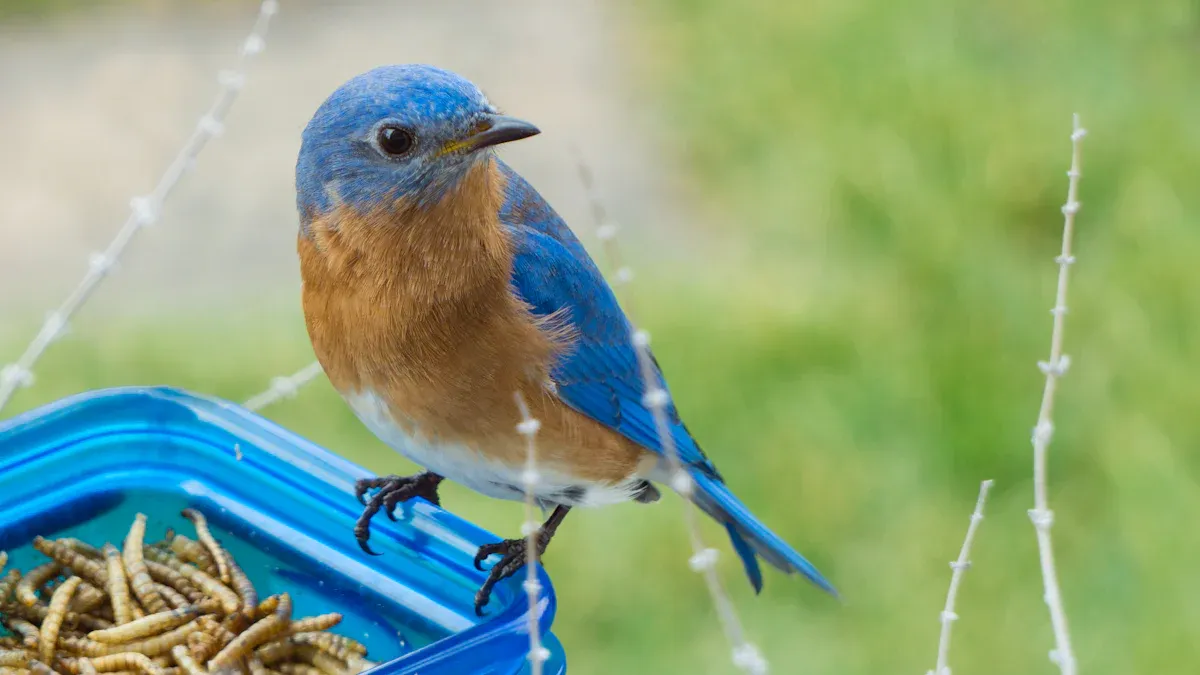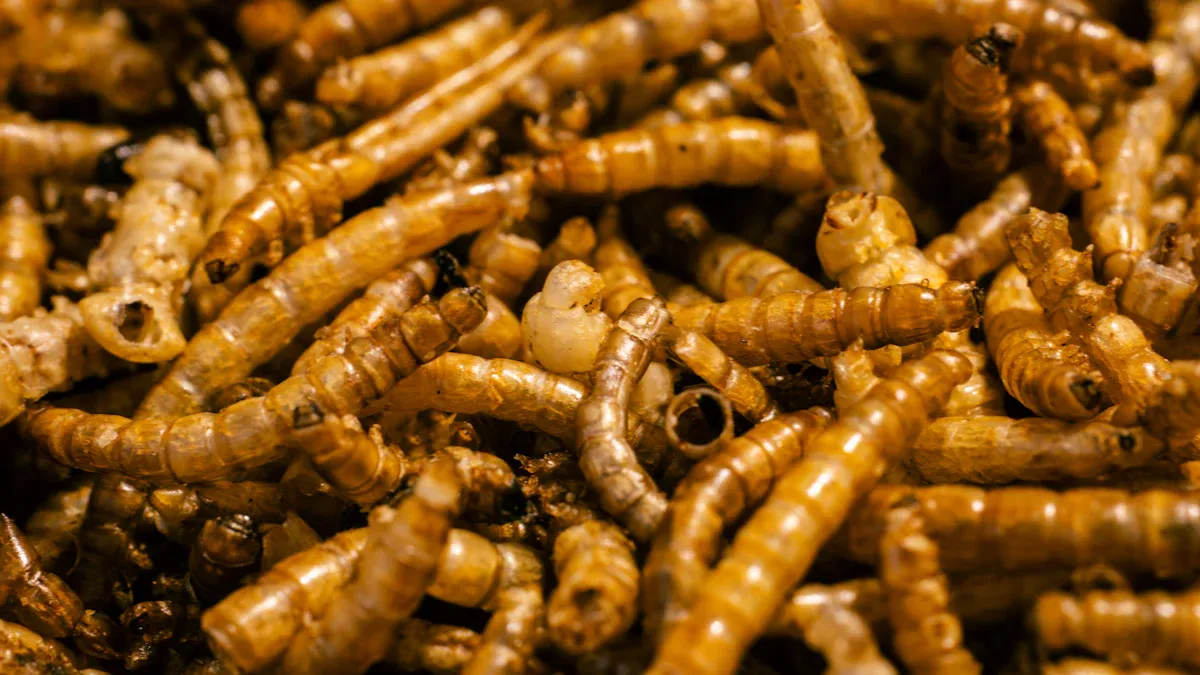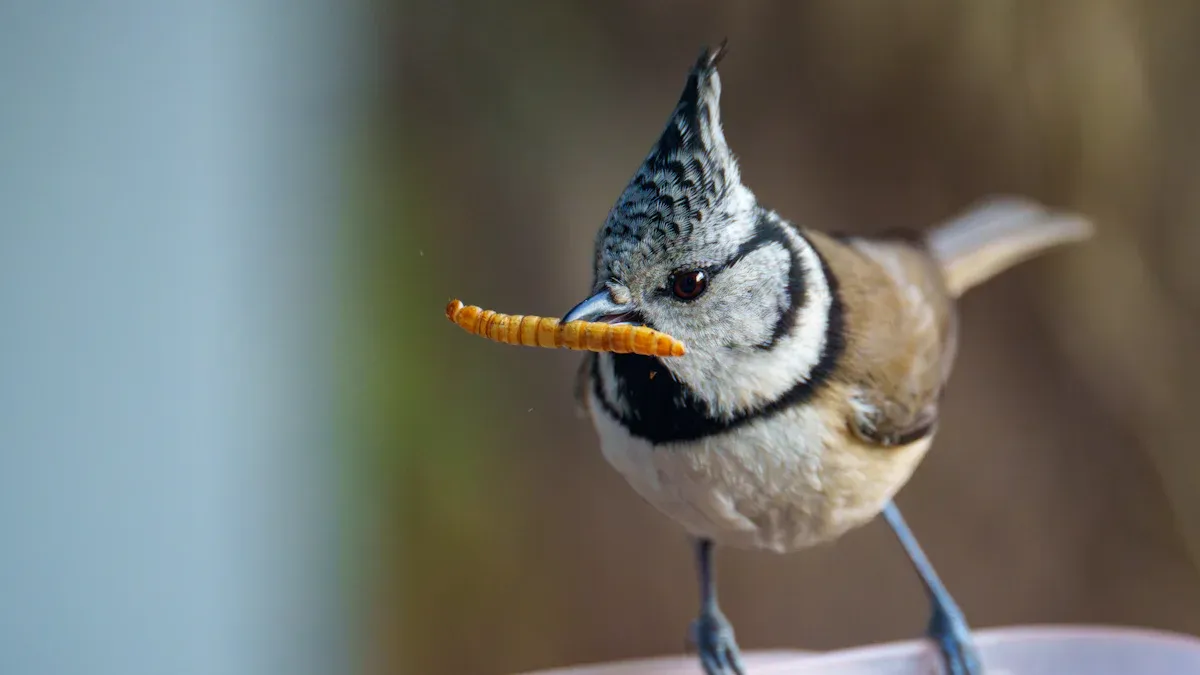
Choosing the right fournisseur de vers à farine is crucial for ensuring that pets receive safe, high-quality nutrition through meal worm feed. Mealworms, which are rich in protein and essential nutrients, play a significant role in supporting pet health. Research indicates that mealworm-based diets, such as Protein70, help maintain ideal health parameters in pets. Furthermore, mealworms provide a sustainable alternative to traditional livestock, as they require fewer resources and generate lower greenhouse gas emissions. Proper storage of mealworm feed is essential to preserve their nutritional value.
Key Takeaways
- Mealworms are rich in protein, with 23.7 grams per 100 grams. They are a great option for feeding pets.
- Picking a trusted mealworm supplier keeps pets safe and healthy. Good quality feed is important for their well-being.
- Storing mealworms in a fridge or freezer keeps them fresh. This also helps keep their nutrients for a long time.
Why Mealworms Are an Excellent Meal Worm Feed

Nutritional Benefits for Pets
Mealworms offer exceptional nutritional value, making them a top choice for pet diets. They contain 23.7 grams of protein per 100 grams, surpassing other insect options like crickets and waxworms. This high protein content supports muscle development and overall health in pets. A study from the University of Illinois confirms that mealworms are digestible and beneficial for pets, including dogs and cats. Their nutrient profile also includes essential vitamins and minerals, contributing to balanced diets for various species.
| Insect Type | Protein (g per 100g) |
|---|---|
| Mealworms | 23.7 |
| Crickets | 20.5 |
| Waxworms | 14.1 |
| Soldier Fly Larvae | 17.5 |
| Silkworms | 9.3 |
| Cockroach Nymphs | 19 |
| House Flies | 19.7 |

Types of Pets That Thrive on Mealworms
Mealworms serve as an excellent feed option for a variety of pets. Reptiles, such as geckos and bearded dragons, benefit from their high protein content. Birds, including chickens and parrots, enjoy mealworms as a nutritious snack. Small mammals like hedgehogs and sugar gliders also thrive on mealworm-based diets. Their versatility makes them suitable for pets with diverse dietary needs.
Sustainability and Environmental Benefits
Mealworms provide significant environmental advantages compared to traditional livestock farming. They require less land, water, and feed, making them a sustainable protein source. Their lower greenhouse gas emissions contribute to reducing the environmental footprint of pet food production. Additionally, mealworms pose a lower risk of zoonotic diseases, enhancing their appeal as an eco-friendly alternative.
| Aspect | Mealworms | Traditional Livestock |
|---|---|---|
| Environmental Footprint | Lower | Higher |
| Land Requirement | Less | More |
| Water Usage | Less | More |
| Feed Conversion Efficiency | Higher | Lower |
| Greenhouse Gas Emissions | Fewer | More |
Mealworms represent a sustainable solution to the challenges posed by conventional livestock farming. Their eco-friendly benefits align with the growing demand for environmentally conscious pet food options.
How to Identify a Reliable Mealworm Supplier
Characteristics of High-Quality Mealworms
High-quality mealworms exhibit specific traits that ensure their nutritional value and safety for pets. Their appearance should be uniform, with a healthy golden-brown color and no signs of discoloration or mold. Mealworms raised on nutrient-rich diets often have superior calcium content and balanced calcium-to-phosphorus ratios. Research highlights that feeding mealworms high-calcium diets significantly enhances their nutritional profile. Additionally, studies from the University of Illinois confirm that mealworms provide highly digestible proteins, with over 90% digestibility for most amino acids. Suppliers adhering to strict quality control measures, including biosecurity protocols and contaminant monitoring, further guarantee the safety of their products.
Ethical Sourcing Practices
Ethical sourcing ensures that mealworms are produced responsibly and safely. Reputable suppliers comply with stringent regulations, such as those in the European food and feed industry. These regulations include monitoring for contaminants like pathogens, heavy metals, and toxins. Suppliers also follow hazard analysis protocols based on HACCP principles to mitigate risks. Ethical practices not only protect the environment but also ensure the health and well-being of pets consuming mealworm-based diets.
Evaluating Customer Reviews and Testimonials
Customer reviews and testimonials provide valuable insights into a supplier’s reliability. Positive feedback often highlights consistent product quality, timely delivery, and excellent customer service. Look for reviews that mention the freshness and nutritional value of the mealworms. Negative reviews, on the other hand, can reveal potential issues, such as delayed shipments or subpar product quality. Platforms like Google Reviews or pet forums can serve as reliable sources for evaluating customer experiences.
Comparing Pricing and Delivery Services
Pricing and delivery services play a crucial role in selecting a mealworm supplier. Competitive pricing should align with the quality of the mealworms offered. Suppliers providing bulk discounts or subscription plans often offer better value for regular buyers. Delivery services should ensure that live mealworms arrive in good condition, with proper packaging to maintain their freshness. Reliable suppliers also provide clear shipping policies and tracking options to keep customers informed about their orders.
Best Practices for Handling and Storing Mealworms

Proper Storage for Live Mealworms
Proper storage ensures mealworms remain healthy and active. A large plastic container with air holes provides an ideal environment. Adding a thick layer of wheat bran or oatmeal as bedding serves as both food and substrate. Maintaining a temperature of 45°F to 50°F in the refrigerator slows their metabolism, allowing them to stay fresh for up to two weeks. After refrigeration, mealworms should be allowed to warm up and become active before feeding. Regular cleaning of the container, including removing waste and old food, prevents contamination and promotes a healthy environment.
Freezing and Preserving Mealworms
Freezing mealworms is an effective way to preserve them for long-term use. Before freezing, ensure they are gut-loaded with nutrient-rich foods for 24-48 hours. This process enhances their nutritional value for pets. Place the mealworms in a sealed, airtight bag to prevent freezer burn. When ready to use, thaw them at room temperature and avoid refreezing to maintain their quality. Freezing is particularly useful for pet owners who prefer to stock up on mealworm feed without worrying about spoilage.
Erreurs courantes à éviter
Several common errors can compromise the quality of mealworms. Storing them at incorrect temperatures, such as above 50°F, can lead to premature pupation or death. Neglecting regular cleaning of the enclosure may result in the buildup of waste and harmful bacteria. Additionally, failing to gut-load mealworms before feeding deprives pets of essential nutrients. Avoid overcrowding the container, as this increases stress and reduces the overall health of the mealworms.
Maintaining Freshness and Nutritional Value
To maintain freshness, mealworms require proper care and feeding. A diet consisting of 70%-85% cereals and carbohydrates, supplemented with fruits or vegetables, ensures they remain nutritious. Providing continuous access to clean water and maintaining 70%-75% relative humidity supports their health. Studies show that high-calcium diets significantly enhance their calcium-to-phosphorus ratios, making them more beneficial for pets. Regular monitoring for disease and implementing hygiene practices further preserve their nutritional value.
Tip: Use red lights during handling to minimize stress and reduce activity levels, making mealworms easier to manage.
Mealworms offer numerous benefits as a pet food source. Their high protein content of 23.7 grams per 100 grams supports pet health better than many other insects. The growing demand for mealworms, projected to reach $1.27 billion by 2030, highlights their nutritional and environmental advantages.
Choosing a trustworthy supplier ensures pets receive safe, high-quality mealworms. Proper storage techniques, such as refrigeration or freezing, preserve their freshness and nutritional value.
Pet owners should prioritize their pets’ well-being by selecting reliable suppliers and handling mealworms correctly. Making informed decisions guarantees pets enjoy a healthy and sustainable diet.
FAQ
What is the best way to store live mealworms?
Store live mealworms in a ventilated container with wheat bran bedding. Keep them refrigerated at 45°F to 50°F to slow their metabolism and extend freshness.
How can I tell if mealworms are fresh?
Fresh mealworms appear golden-brown, active, and free of mold or discoloration. Avoid mealworms with a foul odor or signs of decay.
Are mealworms safe for all pets?
Mealworms suit many pets, including reptiles, birds, and small mammals. However, consult a veterinarian before introducing them to a pet’s diet.


